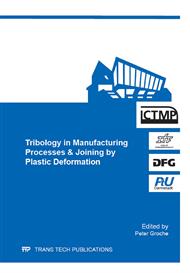p.259
p.270
p.281
p.290
p.301
p.311
p.323
p.336
p.347
Influence of Flow Stress on Lubricating Abilty of Environmentally-Friendly Lubricant for Aluminum Alloy Cold Forging
Abstract:
Although the aluminum fluoride conversion coating has been a popular lubricant for aluminum cold forging in Japan, it has considerable environmental risks and troubles in cost. Double-layer-type environmentally-friendly solid lubricant films have been developed as the substitute. One of the lubricants was evaluated by a friction test based on the combined forward spline-backward can extrusion. The lubricating ability of the double-layer-type lubricant changed through the year. It showed best ability in the rainy season in Japan. Next, the double-layer-type lubricant was applied on three kinds of aluminum alloys to examine the influence of flow stress of materials on the lubricating properties. The lubricating abilities were almost same for each material in the rainy season. Those of the hardest material were higher than others in the winter. Machined and wet-blasted workpieces were tested to investigate the effect of preprocess. A remarkable friction reduction effect by preprocess was observed with the hardest material. The effect of preprocess was not significant for the materials with lower flow stress.
Info:
Periodical:
Pages:
301-310
Citation:
Online since:
June 2014
Price:
Сopyright:
© 2014 Trans Tech Publications Ltd. All Rights Reserved
Share:
Citation:


